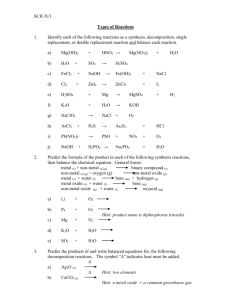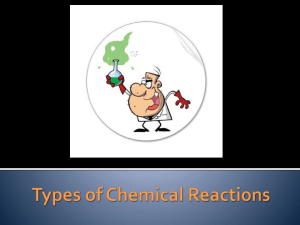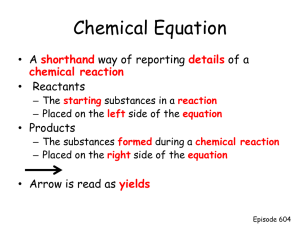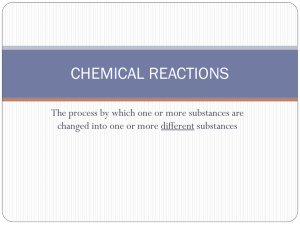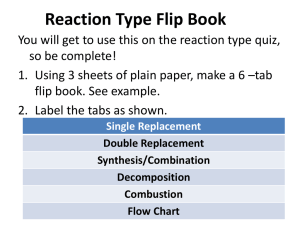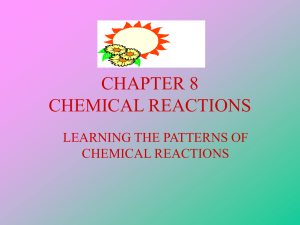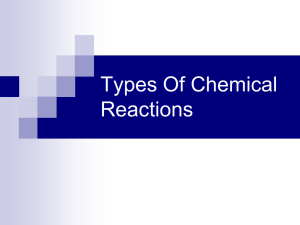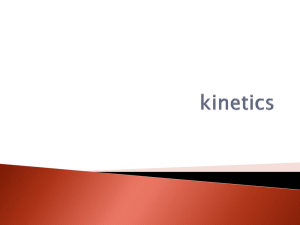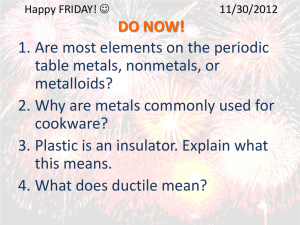Chemical Reaction
advertisement
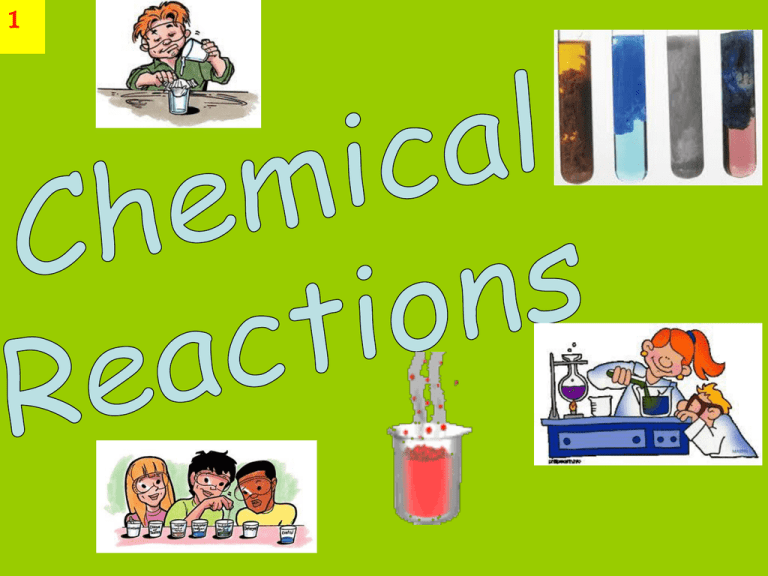
1 2 GOALS 1. Relate how the Law of Conservation of Matter is used to determine chemical composition in chemical reactions. 2. Experimentally determine indicators of a chemical reaction specifically precipitation, gas evolution, water production, and changes in energy to the system. 3. Identify and balance the following types of chemical equations: • Synthesis • Decomposition • Single Replacement • Double Replacement • Combustion 3 Chemical Reactions • A chemical reaction is a change in which one or more substances are converted into new substances. – Rearrangement of bonds in compounds and molecules. • Chemical Equations make it possible to see clearly what is happening during a chemical reaction 4 Visualizing Chemical Reactions • Chemical Reactions are simply the rearrangement of bonds between molecules. Chemical equations are a shorthand way to show chemical reactions. Reactants Products H2 + O2 H2O This is a skeleton equation. It does not show the amounts 5 5 Chemical Equations (more details) • Physical States can be shown by subscripts in parentheses. 6 7 Write the skeleton equations for the following: 1) Hydrogen peroxide Water + Oxygen 2) Methane + Oxygen carbon dioxide + water 3) Aluminum and iodine react to form aluminum iodide 4) Hydrogen iodide gas breaks down into hydrogen gas and iodine gas. During a chemical reaction, mass is conserved. Law of Conservation of Mass 8 The mass of the products always equals the mass of the reactants Antoine Lavoisier 9 Law of Conservation of Mass The mass of the products always equals the mass of the reactants 10 Showing Conservation of Mass in Chemical Formulas H2 + O2 H2O Does this meet the Conservation of Mass 2 Hydrogen 2 Oxygen atoms 2 Hydrogen atoms & one Oxygen atoms atom Law? Must Balance the Equation to show Conservation of Mass. 11 Can add coefficients to Balance equations. 2 H2 + O2 42 Steps: 2 H2O 2 42 21 Balanced!! 1. Count Atoms on both sides 2. If not Balanced, add coefficients to balance. 3. Recount atoms after adding each coefficient. 4. Keep adding coefficients until balanced. 5. Check coefficients to make sure they are the SMALLEST whole number.. 12 1. 2. 3. 4. 5. 6. 7. 8. 9. 10. 11. 12. 13. 14. 15. Balancing Equations Practice ____ K + ____ Cl2 ____ KCl ____ N2 + ____ H2 ____ NH3 ____ N2 + ____ F2 ____ NF3 ____ P4 + ____ Br2 ____ PBr3 ____ GaF3 + ____ Cs ____ CsF + ____ Ga ____ Al + ____ HCl ____ H2 + ____ AlCl3 ____ SO2 + ____ Li2Se ____ SSe2 + ____ Li2O ____ Na3P + ____ CaF2 ____ NaF + ____ Ca3P2 ____ AgNO3 + ____ Li ____ LiNO3 + ____ Ag ____ CH4 + ____ O2 ____ CO2 + ____ H2O ____ BaS + ____ PtF2 ____ BaF2 + ____ PtS ____ Pb(OH)2 + ____ HCl ____ H2O + ____ PbCl2 ____ AlBr3 + ____ K2SO4 ____ KBr + ____ Al2(SO4)3 ____ Na3PO4 + ____ CaCl2 ____ NaCl + ____ Ca3(PO4) ____ LiNO3 + ____ ____ CaBr2 ____ Ca(NO3)2 + ____ LiBr 13 Writing and Balancing Formulas For Reactions Steps • EX: Solid carbon and 1.Determine correct oxygen gas react to formulas for all form carbon dioxide reactants and gas. products. 2.Write the • EX: Aluminum sulfate Skeleton equation. reacts with calcium 3.Use coefficients hydroxide to produce to balance the aluminum hydroxide equation. and calcium sulfate. 14 Writing Formulas Practice • Aluminum metal dissolves in an aqueous solution of sulfuric acid to form hydrogen gas bubbles and a solution of aluminum sulfate. (don’t forget states of matter) Al (s) + H2SO4 (aq) H2 (g) + Al2 (SO4)3 (aq) Balanced: 2Al (s) + 3H2SO4 (aq) 3H2 (g) + Al2(SO4)3 (aq) 15 More Practice • Potassium metal and chlorine gas combine to form potassium chloride. – 2 K + Cl2 2 KCl • Aluminum and hydrochloric acid react to form aluminum chloride and hydrogen gas. – 2 Al + 6 HCl 3 H2 + 2 AlCl3 • Zinc and lead (II) nitrate react to form zinc nitrate and lead. – Zn + Pb(NO3)2 Zn(NO3)2 + Pb • Aluminum bromide and chlorine gas react to form aluminum chloride and bromine gas. – 2 AlBr3 + 3 Cl2 2 AlCl3 + 3 Br2 16 17 Chemical Reactions • You start with one or more compounds and turn it into different compounds. • Indicators of a chemical Reaction – – – – Bubbling (evolution of a gas) Color Change Emission of heat and/or light Formation of new substance • Precipitate – Temperature change Vapors of hydrogen chloride in a beaker and ammonia in a test tube meet to form a cloud of a new substance, ammonium chloride. 18 5 Types of Chemical Reactions 1.Synthesis (combination) 2.Decomposition 3. Single Replacement 4. Double Replacement 5. Combustion Synthesis 19 “to make” A + B Cu + O 2H + O2 2 2 or more smaller chemical substances combine into a new, larger compound. AB CuO 2H O 2 20 Decomposition One larger chemical compound breaking up into 2 or more smaller substances. “to breakdown” Usually require energy AB A + B 2H O 2H + O NaOH Na+ OH 2 2 Animation 2 Single Replacement When one element replaces another element in a compound The more reactive metal will always replace the less reactive metal. 20 A + BC Cu+AgNO3 AC + B Cu(NO3)2+ 2Ag Mg(s) +2HCl(aq) MgCl2(aq) +H2 (g) -The Mg bumps out the H+1 & forms Mg+2 ion in solution Single Replacement The more reactive metal will always replace the less reactive metal. • Metal replaces hydrogen or another metal 21 – use the activity series to predict whether or not certain reactions will occur. – specific metal can replace any metal listed below it 22 Single-Replacement Reactions Predict the products that will result when these reactants combine, and write a balanced chemical equation for each reaction. a. Fe(s) + CuSO4 (aq) → b. Br2 (l) + MgC l2 (aq) → c. Mg(s) + AlCl3 (aq) → 23 Predict the outcome of the reaction 2Fe (s) + 3NiCl2 (aq) 2FeCl3 (aq) + Ni (s) 2Fe (s) + 3CoCl2 (aq) 2FeCl3 (aq) + 3Co (s) 2Fe (s) + 3Pb(NO3)2 (aq) 2Fe(NO3)3 (aq) + 3Pb (s) 2Fe (s) + AlCl3 (aq) No reaction 2Fe (s) + FeCl3 (aq) No reaction 24 Single Replacement • Clip Animation Double Replacement Positive Ion of One compound replaces the positive ion of another compound and a Precipitate is formed. AB + CD Ba(NO3)2+KSO4 25 AD + CB 2KNO3 + BaSO4 **start with 2 AQUEOUS SOLUTIONS, the cations switch anions with each other. Clip Double Replacement • Generally takes place in an aqueous solution 1 of the following is usually true: 1.Precipitate forms 2.One of the products is a gas 3.One of the products is a molecular compound such as water. 26 Clip 27 Animation 28 29 Combustion • Chemical change in which an element or compound reacts with oxygen, often producing energy in the form of heat or light • Always involves oxygen as a reactant. CH4(g) + 2O2(g) CO2(g) + 2H2O(g) 2C4H10 (g) +18O (g) 8CO (g) +10H2O(g) Combustion reactions are almost always exothermic (i.e., they give off heat). Review 30 Identification of Reactions Practice 1. 2. 3. 4. 5. 6. 7. 8. 9. 10. 11. 12. 13. 14. 15. 2 C6H14 + 19 O2 --> 12 CO2 + 14 H2O C 2 C2H2 + 5 O2 --> 4 CO2 + 2 H2O C 8 Cu + S8 --> 8 CuS S P4 + 5 O2 --> 2 P2O5 S H2CO3 --> H2O + CO2 D 2 NaClO3 --> 2 NaCl + 3 O2 D 2 AgNO3 + Ni --> Ni(NO3)2 + 2 Ag SD Ca + 2 HCl --> CaCl2 + H2 SD Ca(C2H3O2)2 + Na2CO3 --> CaCO3 + 2 NaC2H3O2 DD BaCO3 --> BaO + CO2 D 4 Cr + 3 O2 --> 2 Cr2O3 S Cu(OH)2 + 2 HC2H3O2 --> Cu(C2H3O2)2 + 2 H2O DD C3H8 + 5 O2 --> 3 CO2 + 4 H2O C 3 AgNO3 + K3PO4 --> Ag3PO4 + 3 KNO3 DD 2 K + 2 H2O --> 2 KOH + H2 SD 31

